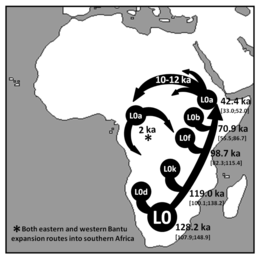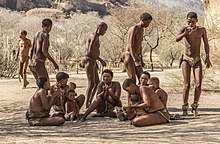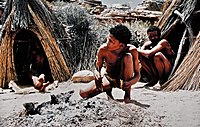Khoisan
Hadzabe |
Khoisan
Many Khoesān peoples are the descendants of a very early dispersal of
Sān are popularly thought of as
Name
The compound term Khoisan / Khoesān is a modern anthropological convention in use since the early-to-mid 20th century. Khoisan is a coinage by Leonhard Schulze in the 1920s and popularised by Isaac Schapera.[5] It entered wider usage from the 1960s based on the proposal of a "Khoisan" language family by Joseph Greenberg.
During the Colonial/Apartheid era, Afrikaans-speaking persons with partial Khoesān ancestry were historically also grouped as Cape Blacks (
The term Khoisan (also spelled KhoiSan, Khoi-San, Khoe-San[7]) has also been introduced in South African usage as a self-designation after the end of apartheid in the late 1990s. Since the 2010s, there has been a "Khoisan activist" movement, demanding recognition and land rights from the government and white minority which owns large parts of the country's private land.[8]

History
Origins

It is suggested that the ancestors of the modern Khoisan expanded to southern Africa (from
Due to their early expansion and separation, the populations ancestral to the Khoisan have been estimated as having represented the "largest human population" during the majority of the
Recent work has suggested that the multi-regional hypothesis may be supported by current human population genetic data. A 2023 study published in the journal Nature suggests that current genetic data may be best understood as reflecting internal admixtures of multiple population sources across Africa, including ancestral populations of the Khoisan.[3]
Late Stone Age

The San populations ancestral to the Khoisan were spread throughout much of southern and eastern Africa throughout the Late Stone Age after about 75 ka. A further expansion dated to about 20 ka has been proposed based on the distribution of the L0d haplogroup. Rosti et al. suggest a connection of this recent expansion with the spread of
The
Against the traditional interpretation that finds a common origin for the Khoi and San, other evidence has suggested that the ancestors of the Khoi peoples are relatively recent pre-Bantu agricultural immigrants to southern Africa who abandoned agriculture as the climate dried and either joined the San as hunter-gatherers or retained pastoralism.[17]
With the hypothesized arrival of pastoralists & bantoid
Today these groups represent the quantitative majority of extant admixed ancient Khoe-San descendants by the millions.[19]
Historical period
The

The so-called "Bushman wars"[year needed]were to a large extent the response of the San after their dispossession.[citation needed]
At the start of the 18th century, the Khoikhoi in the Western Cape lived in a state dominated by the Dutch. By the end of the century the majority of the Khoisan operated as 'wage labourers', not that dissimilar to slaves. Geographically, the further away the labourer was from Cape Town, the more difficult it became to transport agricultural produce to the markets. The issuing of grazing licences north of the Berg River in what was then the Tulbagh Basin propelled colonial expansion in the area. This system of land relocation led to the Khoijhou losing their land and livestock as well as dramatic change in the social, economic and political development.[21]
After the defeat of the Xhosa rebellion in 1853, the new Cape Government endeavoured to grant the Khoi political rights to avert future racial discontent. The government enacted the Cape franchise in 1853, which decreed that all male citizens meeting a low property test, regardless of colour, had the right to vote and to seek election in Parliament. The property test was an indirect way by the British Cape Government (who took over from the Dutch in 1812) to retain a racist based system of governance because on average only white people owned property adequate to meet the test.[22]
In the

The
Following the end of Apartheid in 1994, the term "Khoisan" has gradually come to be used as a self-designation by South African Khoikhoi as representing the "first nations" of South Africa vis-a-vis the ruling Bantu majority. A conference on "Khoisan Identities and Cultural Heritage" was organised by the University of the Western Cape in 1997.[25] and "Khoisan activism" has been reported in the South African media beginning in 2015.[8]
The South African government allowed Khoisan families (up until 1998) to pursue land claims which existed prior to 1913. The South African Deputy Chief Land Claims Commissioner, Thami Mdontswa, has said that constitutional reform would be required to enable Khoisan people to pursue further claims to land from which their direct ancestors were removed prior to 9 June 1913.[26]
-
"Bosjemans frying locusts", aquatint by Samuel Daniell (1805).
-
San woman in Namibia (1984 photograph)
-
Bushman camp 2005
Discoveries
In 2019, scientists from the University of the Free State discovered 8,000-year-old carvings made by the Khoisan people. The carvings depicted a hippopotamus, horse, and antelope in the 'Rain Snake' Dyke of the Vredefort impact structure, which may have spiritual significance regarding the rain-making mythology of the Khoisan.[27]
Violence against the Khoisan
Herero and Namaqua Genocide
In the
Forced relocation in Botswana
In Botswana, many of the indigenous San people have been forcibly relocated from their land to reservations. To make them relocate, they were denied access to water on their land and faced arrest if they hunted, which was their primary source of food.[28] Their lands lie in the middle of the world's richest diamond field. Officially, the government denies that there is any link to mining and claims the relocation is to preserve the wildlife and ecosystem, even though the San people have lived sustainably on the land for millennia.[28] On the reservations they struggle to find employment, and alcoholism is rampant.[28]
Languages

The "Khoisan languages" were proposed as a linguistic phylum by
They are categorized in two families, and a number of possible language isolates.
The
- Northern ǃKung (Sekele), spoken in Angola around the Cunene, Cubango, Cuito, and Cuando rivers (but with many refugees now in Namibia),
- North-Central ǃKung (Ekoka), spoken in Namibia between the Ovambo River and the Angolan border,
- Central ǃKung, spoken around Grootfontein, Namibia, west of the central Omatako River and south of the Ovambo River
- Southeastern ǃKung (Juǀʼhoan), spoken in Botswana east of the Okavango Delta, and northeast Namibia from near Windhoek to Rundu, Gobabis, and the Caprivi Strip.[31]
The
Physical characteristics and genetics
The Khoisan are one of the only populations with epicanthic folds outside of East Asia. They typically have hair texture of the tightest possible curl, a form of kinky hair sometimes referred to as "peppercorn" because of how it can roll into separate rounds on the scalp.
In the 1990s, genomic studies of the world's peoples found that the Y chromosome of San men share certain patterns of polymorphisms that are distinct from those of all other populations.[35] Because the Y chromosome is highly conserved between generations, this type of DNA test is used to determine when different subgroups separated from one another, and hence their last common ancestry. The authors of these studies suggested that the San may have been one of the first populations to differentiate from the most recent common paternal ancestor of all extant humans.[36][37] [needs update]
Various Y-chromosome studies
Similar to findings from Y-chromosome studies, mitochondrial DNA studies also showed evidence that the Khoisan people carry high frequencies of the earliest haplogroup branches in the human mitochondrial DNA tree. The most divergent (oldest) mitochondrial haplogroup, L0d, has been identified at its highest frequencies in the southern African Khoi and San groups.[38][41][42][43] The distinctiveness of the Khoisan in both matrilineal and patrilineal groupings is a further indicator that they represent a population historically distinct from other Africans.[44]
Some genomic studies have further revealed that Khoisan groups have been influenced by 9 to 30% genetic admixture in the last few thousand years from an East African population who carried a Eurasian admixture component.[45] Furthermore, they place an East African origin for the paternal haplogroup E1b1b found in these Southern African populations,[46] as well as the introduction of pastoralism into the region.[47] The paper also noted that the Bantu expansion had a notable genetic impact in a number of Khoisan groups.[46] On the basis of PCA projections, the East African ancestry identified in the genomes of Khoe-Kwadi speakers and other southern Africans is related to an individual from the Tanzanian Luxmanda.[48]
Centre
On 21 September 2020, the
See also
- Bantu peoples of South Africa
- Boskop Man
- Early human migrations
- Ethnic groups in South Africa
- Indigenous peoples of Africa
- San religion
References
- ^ Their total numbers are estimated at roughly 300,000 Khoikhoi and 90,000 San: 200k Nama people (2010): Brenzinger, Matthias (2011) "The twelve modern Khoisan languages." In Witzlack-Makarevich & Ernszt (eds.), Khoisan languages and linguistics: proceedings of the 3rd International Symposium, Riezlern / Kleinwalsertal (Research in Khoisan Studies 29). 100k Damara people (1996): James Stuart Olson, « Damara » in The Peoples of Africa: An Ethnohistorical Dictionary, Greenwood Publishing Group, 1996, p. 137. 50-60k San people in Botswana (2010): Anaya, James (2 June 2010). Addendum – The situation of indigenous peoples in Botswana (PDF) (Report). United Nations Human Rights Council. A/HRC/15/37/Add.2..
- ^ Parkinson, Christian (2016-06-14). "The first South Africans fight for their rights". BBC News.
Most [Khoisan people] now speak Afrikaans as their first language.
- ^ PMID 37198480.
- ^ Barnard, Alan (1992). Hunters and Herders of Southern Africa: A comparative ethnography of the Khoisan peoples. New York, NY; Cambridge, UK: Cambridge University Press.
- ^ Schapera, Isaac (1930). The Khoisan peoples of South Africa: Bushmen and Hottentots. Routledge.
- JSTOR 20004271.
- ^ The hyphenated spelling Khoe-San or Khoi-San is recent (post-1990). Note that this usage is distinct from the occasional usage of Khoi-San for the Khoe-speaking subset of the San, e.g. "the Ai-San, the Kun-San, the Au-ai-san, the An-San, the Matsana-Khoi-San, and the Bushmen of Otave" in John Noble, Illustrated Official Handbook of the Cape and South Africa (1893), p. 395. Spellings Khoi-San and Khoe-San in Mohamed Adhikar, Burdened by Race: Coloured Identities in Southern Africa (2009), p. 148.
- ^ a b Khoisan march to Parliament to demand land rights, ENCA, 3 December 2015. Pelane Phakgadi, Ramaphosa meets aggrieved Khoisan activists at Union Buildings, Eyewitness News, 24 December 2017. Illegitimate Khoisan leaders are trying to exploit new bill, IOL, 17 April 2018.
- PMID 18439549.
Both the tree phylogeny and coalescence calculations suggest that Khoisan matrilineal ancestry diverged from the rest of the human mtDNA pool 90,000–150,000 years before present (ybp)
- PMID 28971970.
- kya): Human-Neanderthal: 530-690, Deep Human [H. sapiens]: 250-360, NKSP-SKSP: 150-190, Out of Africa (OOA): 70–120.
- ^ Crowe, Tim (4 February 2016). "How the origin of the KhoiSan tells us that 'race' has no place in human ancestry". The Conversation. Retrieved 4 August 2022.
- ^ "The Khoisan". South African History Online. 16 January 2020. Retrieved 4 August 2022.
- ^ PMID 24236171.
- ^ Lee, Richard B. (1976), Kalahari Hunter-Gatherers: Studies of the ǃKung San and Their Neighbors, Richard B. Lee and Irven DeVore, eds. Cambridge: Harvard University Press
- S2CID 240934697
- PMID 23516368.
- PMID 24059264.
- ^ The Pear Tree Blossoms, Bernhard Krueger, Hamburg, Germany
- ISBN 978-1-4128-1970-1.
- ^ Fraser, Ashleigh (3 June 2013). "A Long Walk To Universal Franchise In South Africa". Helen Suzman Foundation.
- ISBN 978-0-313-36256-9
- ISBN 9781845454524.
- ^ Hitchcock, Robert K.; Biesele, Megan. "San, Khwe, Basarwa, or Bushmen? Terminology, Identity, and Empowerment in Southern Africa". Kalahari Peoples Fund. Archived from the original on 2 August 2020. Retrieved 15 January 2014.
- ^ Mercedes Besent. "SABC News – Possible constitution changes for Khoisan land claims: Wednesday 16 October 2013". sabc.co.za. Archived from the original on 23 November 2016. Retrieved 11 January 2014.
- ^ EDT, Hannah Osborne On 6/13/19 at 11:49 AM (2019-06-13). "8,000-year-old carvings by ancient humans discovered in world's biggest asteroid impact crater". Newsweek. Retrieved 2020-09-17.
{{cite web}}: CS1 maint: numeric names: authors list (link) - ^ a b c "Botswana bushmen: Modern life is destroying us". BBC News. 7 January 2014. Archived from the original on 25 March 2016. Retrieved 24 July 2016.
- ]
- ISBN 978-3-89645-142-2.[page needed]
- ^ Sands, Bonny (2010). Brenzinger, Matthias; König, Christa, eds. "Juu Subgroups Based on Phonological Patterns". Khoisian Language and Linguistics: the Riezlern Symposium 2003. Cologne, Germany: Rüdiger Köppe: 85–114.
- ^ Charles Darwin (1882). The Descent of Man and Selection in Relation to Sex. London: John Murray. p. 578.
- ^ Schapera, Isaac (1930). The Khoisan Peoples of South Africa: Bushmen and Hottentots. London: Routledge & Kegan Paul Ltd. pp. 59, 62–63, 243.
- ^ Bagnol, Brigitte; Mariano, Esmeralda (2008). "Elongation of the labia minora and use of vaginal products to enhance eroticism: Can these practices be considered FGM?" (PDF). Finnish Journal of Ethnicity and Migration. 3: 42–53. Archived from the original (PDF) on 2022-01-28. Retrieved 2022-01-28.
- ^ "Dwindling African tribe may have been most populous group on planet". sciencemag.org.
- PMID 20164927.
- ^ Mayell, Hillary (December 2002). "Documentary Redraws Humans' Family Tree". National Geographic. Archived from the original on December 22, 2002.
- ^ S2CID 52862939.
- PMID 11420360.
- PMID 21092339.
- PMID 10739760.
- PMID 17656633.
- S2CID 19515426.
- PMID 24550290.
- S2CID 206663925.
- ^ PMID 30192370.
- PMID 34872534.
- PMID 37738339.
- ^ Swingler, Helen (23 September 2020). "UCT launches milestone Khoi and San Centre". UCT News. University of Cape Town. Retrieved 4 January 2021.
 Text may have been copied from this source, which is available under a Attribution 4.0 International (CC BY 4.0) licence.
Text may have been copied from this source, which is available under a Attribution 4.0 International (CC BY 4.0) licence.
Bibliography
- Barnard, Alan (2004) Mutual Aid and the Foraging Mode of Thought: Re-reading Kropotkin on the Khoisan. Social Evolution & History 3/1: 3–21.
- Coon, Carleton: The Living Races of Man (1965)
- ISBN 978-0-393-31755-8..
- Hogan, C. Michael (2008) "Makgadikgadi" at Burnham, A. (editor) The Megalithic Portal
- Lee, Richard B. (1979), The ǃKung San: Men, Women, and Work in a Foraging Society. Cambridge: Cambridge University Press.
- Smith, Andrew; Malherbe, Candy; Guenther, Mat and Berens, Penny (2000), Bushmen of Southern Africa: Foraging Society in Transition. Athens: Ohio University Press. ISBN 0-8214-1341-4
- Thomas, Elizabeth Marshall (1958, 1989) The Harmless People.
- Thomas, Elizabeth Marshall (2006). The Old Way: A Story of the First People.
External links
- The Khoisan-speaking Peoples
- The Khoisan
- Home of the Southern African San
- "Khoesan languages" from Web Resources for African Languages
- Africa's Khoe-San were first to split from other humans
- Khoisan people represent 'earliest' branch off human family tree, By Ian Steadman, 24 September 2012.
- Traditional and Khoi-San Leadership Act, 2019 (in English and Afrikaans)



